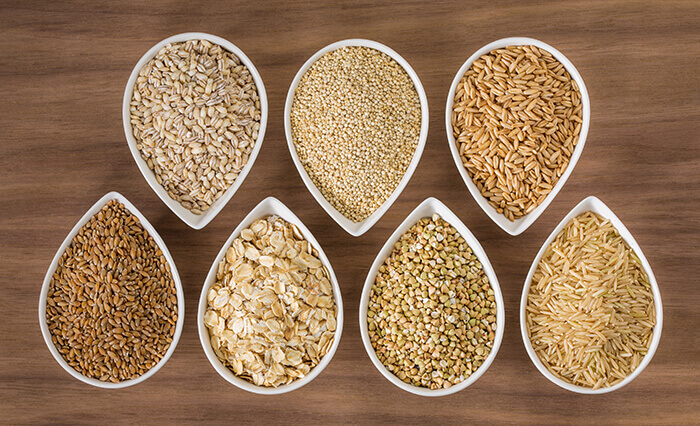The grains & cereals food group includes any grain foods, both wholegrains (and wholewheat) foods, plus the refined grains. Wholegrains are advised to be chosen over refined grains at every meal:
- grains – corn, barley, amaranth, buckwheat, millet, oats, rye, quinoa, wholewheat
- cereals – oats, wholewheat, rye
- rice – brown, wild, basmati, jasmine
- pasta – corn, wholewheat,
- noodles – buckwheat, soy, wheat, rice
How much of the grains & cereals food group is needed
The amount of grains & cereals required each day is dependent on the age and gender of the individual. Grains & cereals contain high levels of fibre, B vitamins, and phytonutrients. The recommended daily intake for this food group is dependent on the age and lifestage of the individual.
** these portions are for inactive to moderately active people; for those that are more active, there is scope to have slightly higher portion sizes
| AGE |
serving size
|
|
|---|---|---|
| CHILDREN | 2-3 years 4-8 years |
3-4
5-7 |
| GIRLS | 9-13 years 14-18 years |
7
9 |
| BOYS | 9-13 years 14-18 years |
9
10 |
| WOMEN | 19-30 years 31-50 years 50+ years |
9
9 7 |
| MEN | 19-30 years 31-50 years 50+ years |
12
10 9 |
| PREGNANT & LACTATING WOMEN | 19-30 years 31-50 years 50+ years |
9
9 7 |
Why the grains & cereals food group is good for you
The grains and cereals food group is healthy because of the following important reasons:
- good source of slow-release energy (wholegrains)
- very high in dietary fibre (both soluble and insoluble fibre)
- foods high in dietary fibre help reduce HDL (“bad”) cholesterol levels
- high fibre foods (such as wholegrains) help to relieve constipation
- have high levels of vital nutrients essential for good health
Portion size
Portion sizes for 1 cup (and equivalent) of grains and cereals are shown below (assume all portions are wholegrain or wholewheat for best health benefits):
| 1 portion | |
|---|---|
| barley | 1/2 cup cooked |
| bread | 1 regular slice 4 small snack-sized rye bread |
| buckwheat | 1/2 cup cooked |
| bulgur | 1/2 cup cooked |
| crackers | 5 wholewheat 2 rye crisp breads |
| kamut | 1/2 cup cooked 85g raw |
| millet | 1/2 cup cooked 85g raw |
| quinoa | 1/2 cup cooked 85g raw |
| muffins | 1 small |
| oats, oatmeal | 1/2 cup cooked 1 packet instant (no sugar) 85g raw |
| rice (brown, wild, basmati, jasmine) |
1/2 cup cooked 85g raw |
| pasta (noodles spaghetti, macaroni) |
1/2 cup cooked 85g raw |
Nutrients
- wholegrains contain high levels of soluble/insoluble fibre which is beneficial for all parts of the digestive system
- the B vitamins are essential for a healthy nervous system:
- chromium is essential for regulating blood glucose levels
- iron is an essential nutrient for forming red blood cells and which many women (including pregnant and lactating mothers) are deficient in this mineral
- magnesium assists with muscle relaxation
- phosphorus is an essential mineral that is required by every cell in the body for normal function and it is especially beeficial for helping the bones absorb and retain calcium
- zinc is an antioxidant which works on maintaining the immune system
Excellent source of energy
- the carbohydrate content of grains and cereals make them useful foods in providing quick energy
- wholegrains and whole cereals provide sustained energy over a longer period
Wholegrains vs processed (white) grains
- wholegrains and wholewheat products have the whole grain (or cereal) and all the vital nutrients intact and are therefore a much more healthier option
- processed grains have the bran removed, which is where much of the nutrients are stored, plus processing of the grains causes loss of other nutrients, so white grains end up having little nutritional value after such processing
- although there are fortified grains and cereals (where the lost nutrients are replaced by the manufacturer in processing), it is still better to eat wholegrain foods
Amount of dietary fat recommended
- Dietary fat should consist of no more than 30% of total daily calorie intake – which is about 50g-60g of fat for a sedentary person on 7500kJ (1800 calories) a day
Amount of dietary protein recommended
- Dietary protein should consist of no more than 0.75g per kilogram body weight of total daily calorie intake – women who are pregnant should add another 6g of protein and lactating women should add 16-12g of protein per day
Amount of dietary carbohydrate recommended
- Dietary carbohydrate should consist of 45%-65% of total daily calorie intake – it is recommended that these come from unrefined sources with a lower glycemic index

